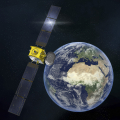17 Nov 2022
In most satellite communication systems, full duplex operation (i.e., simultaneous transmit and receive functionality) is achieved by using two separate frequency channels with spectral filtering employed to achieve the required isolation between signals. With ever-increasing data volume demands accompanied by pressure to reduce the cost per bit delivered, new techniques to utilise the available radio frequency (RF) spectrum more efficiently are continually needed. Simultaneously transmitting and receiving information in a single frequency channel has already proven a viable approach in other wireless communication application domains and has the potential to double total system throughput. Such systems typically employ a combination of both analogue and digital Self-Interference Cancellation (SIC) techniques, together with a careful antenna design and a suitable placement, to achieve the necessary isolation between transmit and receive signals, and such techniques have therefore advanced rapidly over the last few years. Single channel full duplex operation has consequently been supported within consumer (cable) networks since the release of the Data Over Cable Service Interface Specification (DOCSIS) 4.0 in 2017, and integrated wireless access and backhaul for 5G using full duplex is also now becoming a reality. Long-Term Evolution (LTE) products are already available using full duplex such as LTE User Equipment Relays which enable a small cell LTE eNodeB to backhaul to an LTE macro base station using the same access frequencies for both the small cell and the macro network.











